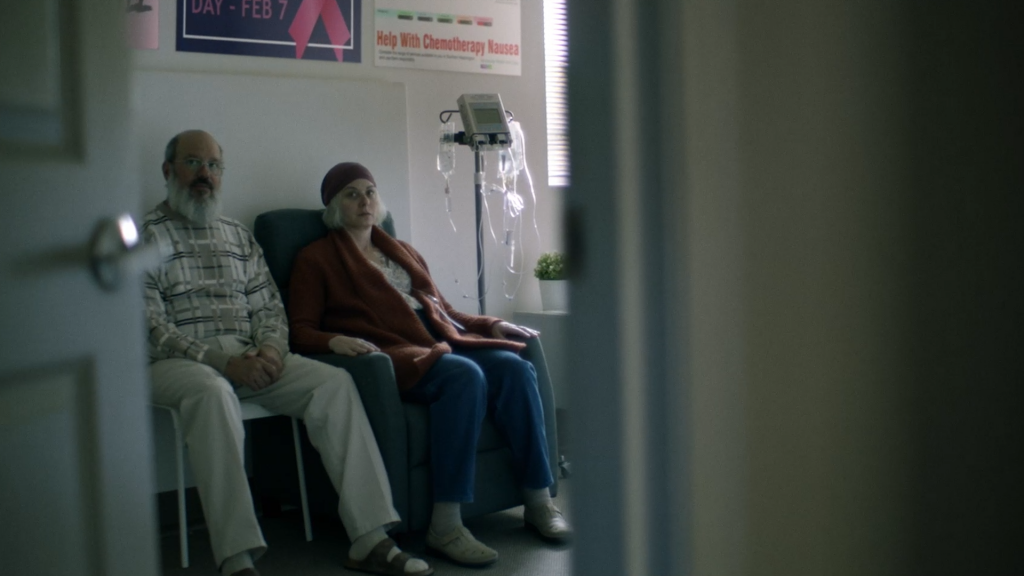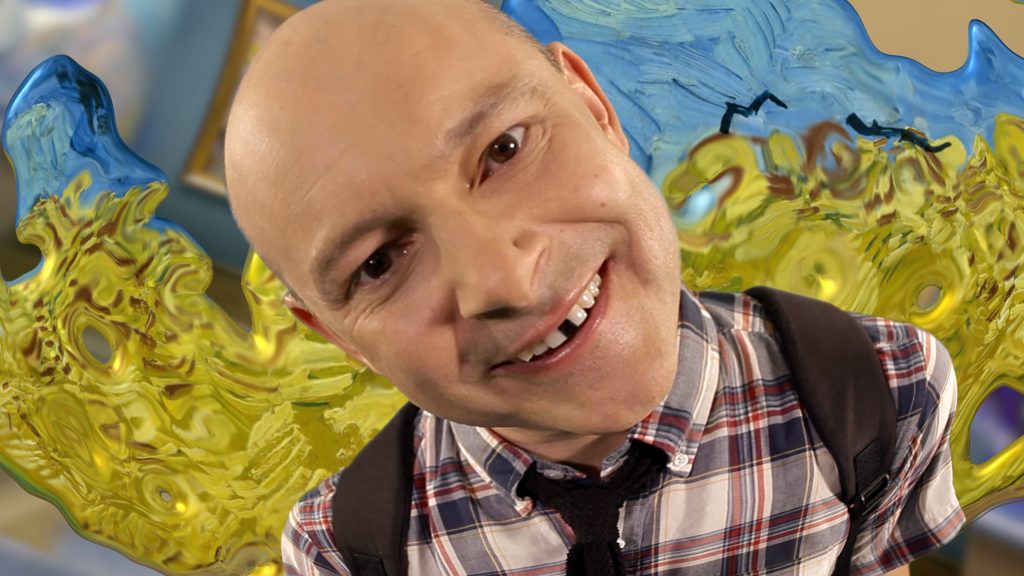September 28, 2020
by Carla Hay

Directed by Tom Putnam
Culture Representation: Taking place in 1995, primarily in Gifford Pinchot National Forest in Washington state, the drama “The Dark Divide” has a predominantly white cast (with a few Native Americans) representing the middle-class.
Culture Clash: A lepidopterist (a person who studies butterflies and moths) defies the expectations of skeptics by going on a scientific exploration that involves camping outdoors for several weeks by himself in a remote forest area.
Culture Audience: “The Dark Divide” will appeal primarily to people who are interested in movies about camping, hiking and dealing with the death of a loved one.

The first scene of the entertaining and occasionally emotionally moving drama “The Dark Divide” is of lepidopterist Dr. Robert “Bob” Pyle (played by David Cross) running in fear somewhere in Gifford Pinchot National Forest in Washington state. Is he running for his life? Is he being chased by Bigfoot, the creature that’s alluded to throughout the movie? The answer comes in the last third of the film.
But before then, “The Dark Divide” (written and directed by Tom Putnam) takes a compelling and sometimes meandering journey with a character who goes on this getaway trip to look for butterflies and moths, but he’s really looking for a way to process his grief over the death of his wife, who was a naturalist and artist. “The Dark Divide” is inspired by the real-life experiences of Bob Pyle, whose wife Thea died of cancer in 2013. Pyle authored the 1995 book “Where Bigfoot Walks: Crossing the Dark Divide.”
In the movie, which takes place in 1995, Bob’s wife Thea (played by Debra Messing) dies about halfway through the film (this is not spoiler information, since her death is the catalyst for Bob taking this fateful trip), after she had a long battle with cancer. The movie isn’t in chronological order, but it’s easy to figure out the order in which things happened. The first third of the movie shows Bob and Thea’s home life. They don’t know it yet but it will be the last year of Thea’s life.
Thea (who has been going through chemotherapy) and Bob try to have as normal as an existence as possible. They attend a cocktail party that has several of Bob’s scientist colleagues who are also in attendance. As a lepidopterist, Bob is interested in trying to save the endangered species of butterflies and moths that he studies. At the party, Bob tells two of his male colleagues—Professor Trimble (played by Shelly Lipkin) and Professor Keasey (played by Tony Doupe)—that he’s thinking about going to Gifford Pinchot National Forest to find any of these endangered species.
“Unless we catalogue all the species there, how do we know if the numbers are dwindling?” Bob asks the colleagues. The colleagues agree, but they react with skepticism that Bob is qualified to do this kind of field work by himself. They ask him what his experience is with camping, and he admit it’s minimal and that he hasn’t really gone camping since he was a child. And he’s never done any training on how to survive in a remote, outdoor area.
Meanwhile, back at home, Thea and Bob have moments of despair about her cancer. Bob can only comfort Thea when he does heartbreaking things like help her in the bathroom when she vomits or when he accompanies her to doctor appointments for her cancer treatment. Thea is generally more accepting of her cancer diagnosis than Bob seems to be. She makes it clear to Bob and anyone else that she doesn’t want their pity.
One day, Bob is working on his front-door porch with his typewriter, and all he can type is the word “cancer.” Thea notices Bob is in a mopey mood and she says to him, “Bob, why don’t you dial back on being miserable?” He replies, “I’m sorry but my wife is …” He can’t finish saying the words he wants to say, so Thea finishes the sentence with what she wants to say: “Alive.”
Thea tells Bob to “go with your girlfriend Marcia to look for specimens, scribble down that poetry you keep threatening to write, and just get away from me for a while.” (Marcia is the nickname for Bob’s butterfly net.) Bob takes her advice, but while out camping, he soon finds out that his colleagues were right: He doesn’t know much about survival in the outdoors.
When some Girl Scouts walk past his campsite, one of the girls tells Bob how he stored his food in the wrong way. He needed to use branches to hang the food so that bears couldn’t get to it. You know you’re ill-equipped to be go camping in the woods when a Girl Scout knows more than you do. Later, Bob nearly falls down a cliff while trying to catch a butterfly in his net.
Bob and Thea have a loving relationship, and Thea tries to lift his spirits during the cancer ordeal with her dry sense of humor. In one scene, when they are home alone together, Thea says to Bob: “Knock, knock.” Bob replies, “Who’s there?” Thea answers, “Death.”
Bob says, “That’s not funny.” Thea responds, “I’m sorry. It was a little funny.” Bob reluctantly admits that the joke was “a little funny,” and they both have a laugh over it. This tender moment is referenced later in the movie to great emotional effect when Bob has a life-or-death situation and he doesn’t know if he’s going to make it out alive.
After Thea dies, Bob gets a letter in the mail informing him that he’s gotten a Guggenheim grant for $11,000 to study the endangered species at Gifford Pinchot National Forest. The grant is his motivation to go back to the forest. The trip is also his way of honor Thea after she died, since Bob and Thea’s relationship was strengthened by their common passion for nature and animals. (Cross and Messing are very good in their roles as Bob and Thea. The couple’s marriage is the soul of this movie.)
Before he heads into the very remote area of the woods, Bob stops off at a convenience store to buy food and supplies. He sees a newspaper tabloid in the store with a front page story titled “I Was Bigfoot’s Love Slave.” The store clerk named Monty (played by Cameron Esposito) notices Bob glancing at the tabloid story and says, “Tourists go nuts for that crap.”
Bob has a map and asks the clerk for directions on where he needs to go. Monty looks at Bob and tells him that the trail where he wants to go is “no joke” and that Bob doesn’t look very well-equipped to handle the treacherous terrain. The warning doesn’t really scare Bob, who is determined to achieve his goals to look for the specimens that he wants to find.
The rest of the movie shows Bob experiencing a series of mishaps and some strangers during his mostly lonely trip. Some of the strangers are friendlier than others. Some of them (such as a group of construction workers in the forest) are hostile to environmentalists, so Bob is careful about who he tells that he’s very much a pro-conservation person who believes in protecting endangered species as much as possible.
Bigfoot is a possible looming presence in the area. Many of the people who are in the forest believe that Bigfoot exists, while Bob doesn’t believe in Bigfoot or any creature that can’t be scientifically explained or proven. One of the most memorable encounters that Bob has is with a family of hikers, who almost shoot him because they think he might be Bigfoot.
Bob ends up briefly hanging out over a campfire at night with this family, which consists of a middle-aged married couple named Teresa (played by Kimberly Guerrero) and Shayne (played by David Koechner); Teresa’s young-adult son Billy (played by Dyami Thomas) from a previous relationship; and Teresa’s mother Marie (played by Harvest Moon), who was the one who was convinced that Bob could’ve been Bigfoot when the family first saw him in the woods.
Billy and Marie are the two people in the family who are the most convinced that the legend of Bigfoot is true. (Everyone in the family is Native American except for Shayne, who is white.) Over the campfire, Billy says, “When white man gets too greedy, Bigfoot smashes his truck as revenge.”
Not long after Bob amicably parts ways with this family, he sees that a construction work site in the woods has been vandalized. Bob gets falsely accused by some of the workers of causing the damage, but he convinces them he didn’t do it. And in another scene, Bob sees an ape-like footprint that’s twice the size of a man’s footprint. Coincidence?
“The Dark Divide” isn’t really a story about Bigfoot conspiracy theories or legends. Instead, the movie (which has stunning cinematography by Sean Bagley, especially the sweeping aerial views of nature) is often a meditative piece that shows Bob communing with nature and being alone with his thoughts. Because he encounters his own precarious situations on this trip, it gives him a new appreciation of life. People should not expect a fast-paced wilderness adventure story with this quietly effective movie because it’s about facing grief and inner demons instead of any dangerous creatures in the woods.
Strike Back Studios and REI Co-op Studios released “The Dark Divide” in select U.S. cinemas on September 18, 2020. The movie’s VOD release is on November 10, 2020.


